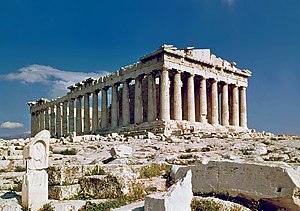
Back Parthenon Afrikaans Parthenon ALS ፓርቴኖን Amharic Partenón AN Parþenon ANG بارثينون Arabic معبد بارثينون ARZ পাৰ্থেনন মন্দিৰ Assamese Partenón AST Parfenon Azerbaijani
| Parthenon | |
|---|---|
Παρθενώνας | |
 The Parthenon in 1978 | |
 | |
| General information | |
| Type | Temple |
| Architectural style | Classical |
| Location | Athens, Greece |
| Coordinates | 37°58′17″N 23°43′36″E / 37.9715°N 23.7266°E |
| Construction started | 447 BC[1][2] |
| Completed | 432 BC;[1][2] 2456 years ago |
| Destroyed | Partially in 1687 |
| Height | 13.72 m (45.0 ft)[3] |
| Dimensions | |
| Other dimensions | Cella: 29.8 by 19.2 m (98 by 63 ft) |
| Technical details | |
| Material | Pentelic Marble[4] |
| Size | 69.5 by 30.9 m (228 by 101 ft) |
| Floor area | 73 by 34 m (240 by 112 ft)[5] |
| Design and construction | |
| Architect(s) | Iktinos, Callicrates |
| Other designers | Phidias (sculptor) |
The Parthenon (/ˈpɑːrθəˌnɒn, -nən/; Ancient Greek: Παρθενών, romanized: Parthenōn [par.tʰe.nɔ̌ːn]; Greek: Παρθενώνας, romanized: Parthenónas [parθeˈnonas]) is a former temple[6][7] on the Athenian Acropolis, Greece, that was dedicated to the goddess Athena during the fifth century BC. Its decorative sculptures are considered some of the high points of classical Greek art, an enduring symbol of Ancient Greece, democracy, and Western civilization.[8][9]
The Parthenon was built in thanksgiving for the Hellenic victory over Persian Empire invaders during the Greco-Persian Wars.[10] Like most Greek temples, the Parthenon also served as the city treasury.[11][12]
Construction started in 447 BC when the Delian League was at the peak of its power. It was completed in 438 BC; work on the decoration continued until 432 BC. For a time, it served as the treasury of the Delian League, which later became the Athenian Empire. In the final decade of the 6th century AD, the Parthenon was converted into a Christian church dedicated to the Virgin Mary. After the Ottoman conquest in the mid-fifteenth century, it became a mosque. In the Morean War, a Venetian bomb landed on the Parthenon, which the Ottomans had used as a munitions dump, during the 1687 siege of the Acropolis. The resulting explosion severely damaged the Parthenon. From 1800 to 1803,[13] the 7th Earl of Elgin took down some of the surviving sculptures, now known as the Elgin Marbles or simply Greek Marbles, which, although he had the permission of the then Ottoman government, has subsequently become controversial.[14]
The Parthenon replaced an older temple of Athena, which historians call the Pre-Parthenon or Older Parthenon, that was demolished in the Persian invasion of 480 BC.
Since 1975, numerous large-scale restoration projects have been undertaken to preserve remaining artifacts and ensure its structural integrity.[15][16]
- ^ a b Parthenon Archived 5 March 2011 at the Wayback Machine. Academic.reed.edu. Retrieved on 4 September 2013.
- ^ a b The Parthenon Archived 2 July 2017 at the Wayback Machine. Ancientgreece.com. Retrieved on 4 September 2013.
- ^ Penprase, Bryan E. (2010). The Power of Stars: How Celestial Observations Have Shaped Civilization. Springer Science & Business Media. p. 221. ISBN 978-1-4419-6803-6. Retrieved 8 March 2017.
- ^ Sakoulas, Thomas. "The Parthenon". Ancient-Greece.org. Retrieved 15 December 2020.
- ^ Wilson, Benjamin Franklin (1920). The Parthenon at Athens, Greece and at Nashville, Tennessee. Nashville, Tennessee: Stephen Hutcheson and the Online Distributed. Archived from the original on 6 June 2021. Retrieved 11 November 2020.
{{cite book}}: CS1 maint: bot: original URL status unknown (link) - ^ Barletta, Barbara A. (2005). "The Architecture and Architects of the Classical Parthenon". In Jenifer Neils (ed.). The Parthenon: From Antiquity to the Present. Cambridge University Press. p. 67. ISBN 978-0-521-82093-6.
The Parthenon (Plate 1, Fig. 17) is probably the most celebrated of all Greek temples.
- ^ Sacks, David. "Parthenon". Encyclopedia of the Ancient Greek World, David Sacks, Facts On File, 3rd edition, 2015. Accessed 15 July 2022.
- ^ Beard, Mary (2010). The Parthenon. Profile Books. p. 118. ISBN 978-1-84765-063-4.
- ^ Cite error: The named reference
:2was invoked but never defined (see the help page). - ^ Cite error: The named reference
:0was invoked but never defined (see the help page). - ^ Robertson, Miriam (1981). A Shorter History of Greek Art. Cambridge: Cambridge University Press. p. 90. ISBN 978-0-521-28084-6.
- ^ Davison, Claire Cullen; Lundgreen, Birte (2009). Pheidias:The Sculptures and Ancient Sources. Vol. 105. London: Institute of Classical Studies, University of London. p. 209. ISBN 978-1-905670-21-5. Retrieved 10 September 2017.
- ^ "Lord Elgin and the Parthenon Sculptures". British Museum. Archived from the original on 3 February 2013.
- ^ "How the Parthenon Lost Its Marbles". History Magazine. 28 March 2017. Archived from the original on 17 April 2019. Retrieved 17 April 2019.
- ^ "Reasons of Interventions". ysma.gr.
- ^ Magazine, Smithsonian. "Unlocking Mysteries of the Parthenon". Smithsonian Magazine. Retrieved 23 July 2022.
© MMXXIII Rich X Search. We shall prevail. All rights reserved. Rich X Search